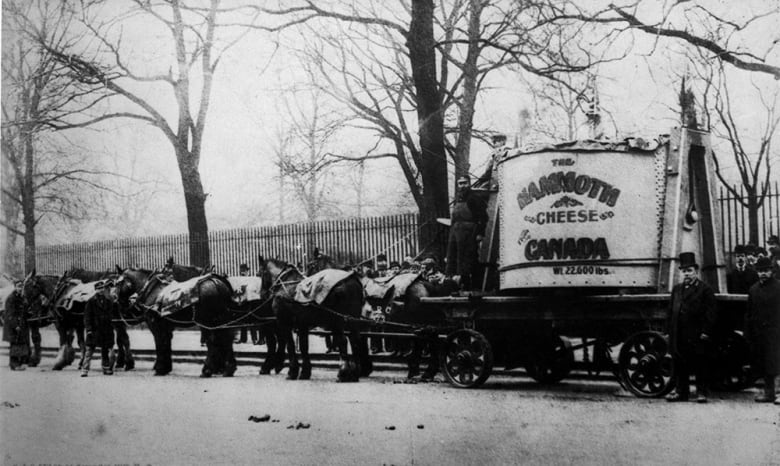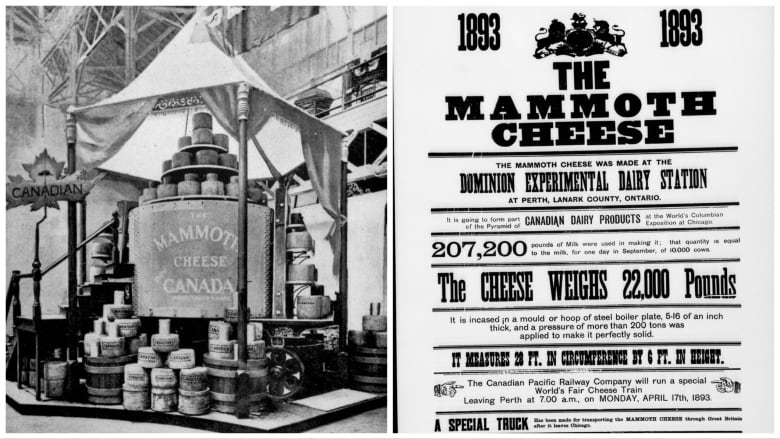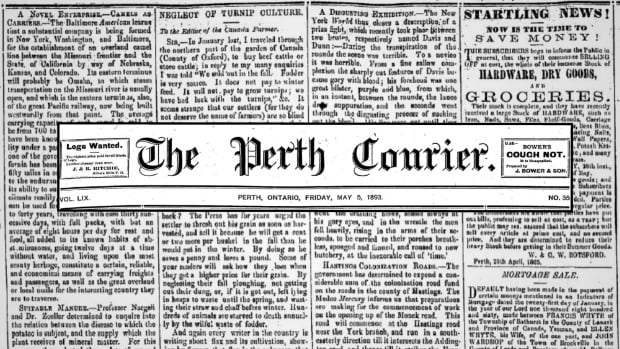A column within the native newspaper in Perth, Ont., warns about “younger bucks” who race by means of city at a “livid tempo,” risking the lives of pedestrians.
The grievance, unlikely although it might appear, has nothing to do with automobiles.
Printed in 1866, the nameless column anticipated a “critical calamity” would “little doubt” happen if reckless drivers could not rein of their horse and buggy.
The story and numerous others — revealed over practically two centuries within the pages of the Perth Courier — now dwell on rows of cabinets at Archives Lanark, housed within the places of work of the previous Township of Drummond, about 80 kilometres southwest of downtown Ottawa.
The archived newspapers maintain snapshots of Perth historical past, from warnings about an advancing cholera outbreak, to a lament in regards to the decline of “turnip tradition,” to a barrage of adverts peddling “victory bonds” throughout the Second World Struggle.
A collage of varied adverts from digitized copies of the Perth Courier. (Perth Courier)
Copies of the Courier at Archives Lanark had steadily amassed, one week at a time, since the newspaper was first revealed in 1834.
Then, just a few weeks in the past, that stopped.
On Sept. 15, Ontario Chronicle sister firm Metroland Media Group introduced it had sought chapter safety and was shedding dozens of journalists and shutting down print operations at 70 of its group newspapers.
One thing about sitting down and studying a newspaper.- Judy Brown, Mayor of Perth
Within the Ottawa space, that meant the lack of paper copies of the Kemptville Advance, the Renfrew Mercury and the Perth Courier, every among the many nation’s oldest newspapers.
“We’re all devastated,” mentioned Marilyn Snedden, vice-chair of Archives Lanark. “It is simply one other signal of actual altering instances.”
Not like the close by impartial Glengarry Information, which just lately shuttered each its print and digital publications, the Metroland newspapers live on as a part of the Inside Ottawa Valley web site.
A ‘victory bonds’ cartoon revealed within the Oct. 23, 1943 situation of the Perth Courier. (Perth Courier)
However that protection, based on Snedden, is “no comparability in any respect” to the quantity of native tales that when made it to print.
Perth Mayor Judy Brown mentioned she felt a “sense of loss” when she discovered the print paper had come to an finish.
“Form of like dropping an outdated buddy,” she mentioned. “It is at all times been round. I used to be shocked after I came upon.”
Brown used to work for the Courier, however left after Metroland Media purchased the newspaper in 2006. She mentioned the tip of the print version comes after a gradual decline in native content material, written by a dwindling pool of native reporters.
“To some extent, it takes away from the sense of group,” she mentioned. “[There’s] one thing about sitting down and studying a newspaper.”
The next three tales, every pulled from the Courier’s digitized archives, seize a glimpse into the city’s historical past.
The ghost home
On Jan. 13, 1935, “upwards of 100 autos” descended on a home close to the outskirts of Perth, the drivers hoping to glimpse any of the “bizarre and mysterious incidents” just lately reported there.
In keeping with a narrative within the Courier later that week, “a profound sensation” had unfold from the small log home situated in present-day Tay Valley Township throughout “the size and breadth of Canada.”
Widespread newspaper protection and a CBC Toronto radio broadcast helped generate curiosity in a sequence of unusual incidents mentioned to be going down on the Quinn household house.
A picture of the Quinn home close to Perth from the Jan. 25, 1935 copy of the Courier. (Perth Courier)
The listing within the Courier included range lids that danced within the air, home windows smashed by levitating stones and three flat-irons that walked step-by-step down the steps.
“One other customer was struck behind the top by a clothespin,” the newspaper reads.
Ontario Provincial Police (OPP) deemed the stories credible sufficient to ship two officers to the premises.
The Courier described the scene on the home on an evening when consideration had reached a peak.
“The room was lit by a kerosene lamp. The lads have been in small teams all speaking in low voices as at a funeral,” the paper reads.
By round midnight, a police officer and his companion have been the one folks nonetheless awake on the primary flooring, based on the Courier, whereas two neighbours of the Quinn household saved watch on the door.
“Exterior the home the mercury slipped beneath zero, and the little home with damaged home windows was very chilly,” the story reads. “Nonetheless nothing occurred.”
And nonetheless much less in regards to the supposed haunting reached the pages of the Courier — till a long time later when the home reappeared on the entrance web page.
 A clipping from the Jan. 6, 1972 situation of the Courier describes the razing of the previous Quinn home. (The Perth Courier)
A clipping from the Jan. 6, 1972 situation of the Courier describes the razing of the previous Quinn home. (The Perth Courier)
On Jan. 6, 1972, the newspaper reported the previous Quinn home had been razed to the bottom in a mysterious fireplace.
Though the thriller of who did it remained unsolved, by then, a clearer understanding of its haunted previous had emerged.
Two months after the stories of smashed home windows and animated flat-irons, Perth OPP had arrested the eldest Quinn boy in connection to an unrelated arson case.
The boy was charged for the crime, and he admitted throughout questioning he’d been the “ghost” of the house months earlier.
“On the time many individuals felt that the boy created the ‘ghost’ to assist his mom who needed to maneuver from the realm,” the paper reported, “whereas the daddy was content material to dwell within the house.”
The ‘Company Child’
Within the 1860s, infants have been usually deserted on stoops throughout city.
With no agency coverage to cope with the issue, council resorted to advert hoc measures for a minimum of one deserted toddler, referred to within the Courier because the “Company Child.”
In Might 1865, council granted $5 to a widow recognized as Mrs. Smith for taking good care of “the foundling little one left with the Market Clerk a while in the past.”
“There are few on the town, we expect, who will begrudge Mrs. Smith the small pittance she obtained for all her bother,” the paper reads.
However only one month later, the newspaper mentioned how some members of council had begun to begrudge the expense. It described native politicians as being “in a state of perplexity in regards to the disposal of the infant.”
“A lot of the household males amongst them appear to assume that the poor little lump of humanity ought to be offered for not directly on the public expense,” the story reads.
“Whereas the bachelors … grumble on the price, and darkly trace at one thing that seems like sending the teen away.”
The newspaper proposed the council levy a tax on all single males in Perth over the age of 25 to assist help the deserted youngsters.
Finally, for the worth of $25, a resident agreed to take possession of the Company Child till she reached maturity. What occurred to her, nonetheless, seems to be misplaced to historical past.
The mammoth cheese
A newspaper commercial within the Perth Courier marked the approaching World’s Columbian Exposition, a good held in Chicago in 1893.
“The World’s Truthful. Are you going?” the advert asks. “The Grand Trunk R. R. situation tickets from Perth to Chicago at lowest charges.”
For individuals who went, the Canadian cheese exhibit was a key attraction. The centrepiece: a “Mammoth Cheese” weighing roughly ten tonnes and measuring about two metres tall and greater than eight metres round.
Made in Perth, the cheese reportedly contained a single day’s milk from 10,000 cows. Twelve of the most important cheese factories in Ontario contributed curd.
 ‘The Mammoth Cheese’ leaves Perth en path to the 1893 World’s Columbian Exposition in Chicago. (Beckett, Donald C./Library and Archives Canada/PA-160538)
‘The Mammoth Cheese’ leaves Perth en path to the 1893 World’s Columbian Exposition in Chicago. (Beckett, Donald C./Library and Archives Canada/PA-160538)
A sequence of breathless dispatches from Chicago appeared within the Courier — many describing the cheese in minute element.
“It’s encased in a vat of riveted metal boiler plate, and this boiler plate rides on a wide-wheeled truck,” one story reads.
“The odor of cheese is plainly discernible when close to by,” reads one other. “The group at all times congested right here when the massive cylinder of cheese and its labelling met the attention of the wandering customer.”
 The cheese show in Chicago proven subsequent to a poster promoting the cheese. (Beckett, Donald C./Library and Archives Canada/PA-160538/Library and Archives Canada/PA-160539)
The cheese show in Chicago proven subsequent to a poster promoting the cheese. (Beckett, Donald C./Library and Archives Canada/PA-160538/Library and Archives Canada/PA-160539)
The newspaper described how a plug practically a metre lengthy was bored out of the cheese and inspected by judges, ultimately incomes a rating of 95 factors out of 100.
“The feel was exceedingly good,” the reporter wrote. “The flavour was a little bit sharp and biting, however splendidly superb, all issues thought of.”
On Oct. 23, 1943, the newspaper lined a ceremony in Perth unveiling a concrete duplicate of the enormous cheese for the fiftieth anniversary of the unique delicacy.
Greater than 50 years later and the cheese monument stays — its historical past remembered in archived copies of the Perth Courier.









